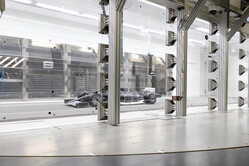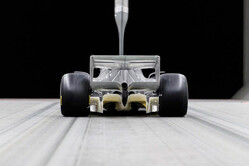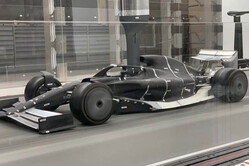


22/08/2019
NEWS STORY
 The FIA has revealed video footage of wind tunnel testing of a 50% scale model of the proposed look for F1 cars in 2021.
The FIA has revealed video footage of wind tunnel testing of a 50% scale model of the proposed look for F1 cars in 2021.
According to the sport's governing body, ahead of the German Grand Prix, a model of the latest 2021 iteration was put in the Sauber wind tunnel.
The test followed a debut run in January, when a 2018 60% model was used, and a second run in March, when an iteration of the 2021 car was tested with 13-inch wheels.
Though the general results will be shared with all teams, Sauber's independent consultancy group ran the wind tunnel ensuring that their F1 team gained no advantage.
Elements such as the sidepod areas and rear wing are expected to remain the same in the final iteration, however the front wing will evolve as development continues.
In the video, fans get a rare glimpse into a wind tunnel with the 2021 50% scale model running for the first time with 18-inch tyres.
There is a rake moving up and down behind the car to measure the airflow behind the car allowing F1 and the FIA to monitor the wake as they bid to improve a car's ability to follow another.
{youtube sn2eisHLwwk 560x315}
"Typically teams would not use a rake in this position because teams don't really care about the wake of the car," explains FIA Head of Single Seater Technical Matters, Nikolas Tombazis. "That's not a criticism; teams are simply trying to maximise the performance of their own car, which is completely understandable. We, however, are more interested in what happens behind the car. The fundamental point of all of this is that we are trying to reduce the losses that the following car would face."
Pat Symonds, Chief Technical Officer at Formula 1 adds that while the bulk of the development work taking place has been conducted using CFD (Computation Fluid Dynamics) the wind tunnel tests offer a real-world validation of the modelling carried out in the virtual space. "While the CFD tools we are using feature some pretty advanced techniques which aren't commonly used by the teams, we want to back up the virtual simulations with a physical simulation," he said.
An advantage of using the Sauber wind tunnel, which is available for commercial hire, is that the Swiss operation has a very good automatic rake system.
"The rake features an array of pitot tubes with yaw sensitivity, so they can measure the direction, pressure and the velocity of the flow, mainly the velocity components and the pressure," adds Tombazis. "In that way we can make sure that what the CFD is predicting is correct.
"The simplification of the leading car's aerodynamics also helps for wake performance because on the one hand the front car doesn't have as many methods to control its wake. On the other hand the following car, not having all these little, very sensitive devices is less susceptible to disruption."
Traditionally 100% scale cars are not used in a wind tunnel as their use was banned some years ago due to the huge cost of producing the model. Most teams have moved to using 60% models, but F1 and the FIA have opted to work with a 50% scale.
"We also chose to use a 50% model rather than a 60% model and we chose to run that model quite a long way forward in the wind tunnel, so this gave us the opportunity to best inspect the wake of the car," adds Symonds.
"It takes up less room in the tunnel and therefore it allows us to look, in terms of car lengths, further behind. If you imagine you have a full size car in there, you could only look at a tenth of a car when it is behind, so 50% is a good compromise in that we can still get a good level of detail on the model but we still have distance behind. It is true that teams have tended to go more to 60% these days. There are advantages to that, in modelling, but modern manufacturing techniques, particularly additive manufacturing methods, allow you to make very accurate 50% models these days."
 Asked why a second car wasn't placed behind the front car to test the wake, Symonds said that it was "not necessary".
Asked why a second car wasn't placed behind the front car to test the wake, Symonds said that it was "not necessary".
"We did do that in 2008, with the overtaking studies we did then for 2009, and for that, we had to go down to a quarter scale model which really is getting too small," he explains. "That is what negates us doing it. Even in a big tunnel like Sauber's, you could only really run one configuration with the cars really very close. What we're trying to do is use CFD as our real simulation tool and this is just the correlation."
One of the chief targets of the 2021 rules is to see more overtaking. To do this, there is a push to find a way to allow the cars to follow each other more closely, which is why there has been so much research into reducing the wake.
Asked what have months and months of CFD testing and runs in the wind tunnel have revealed, Tombazis said: "That fundamentally the CFD was correct. There have been no major surprises. So there is a 5-10% wake disruption, compared to the current levels of 50%, although it depends on the exact configuration you are testing and so on."
The results are "actually beyond what I thought we could achieve when we started the project," adds Symonds. "With the configurations we have got at the moment, the results are exceptional."
The FIA and F1 are working hand in hand on the research and development to finalise the 2021 regulations in time for the October deadline – but that doesn't mean they are excluding the teams. In fact, it's quite the opposite, according to the FIA. The teams have been invited to help with the gathering of data and the development process, with the FIA allowing them to do the testing outside the number of hours they are allocated for their current projects. Those who have the resource and capability to do that have done so. Those who don't still get the information.
"The teams have also contributed across the board on the CFD side," says Tombazis. "Normally teams have a limit in how much CFD they can do but we've periodically offered them the option to do some work outside the limit that contributes to certain topics related to 2021 rules. Quite a few teams have contributed and they have to then share the results with the FIA, with Formula 1 and with the other teams."
A large part of the focus of the FIA and F1 has been on trying to reduce the effects the wake generated by a leading car has on a chasing car's ability to follow, in order to provide closer racing and improved overtaking opportunities.
This, of course, runs counter to the aims of an F1 team, where their only desire is to beat their rivals. And if part of the victory is obtained by disrupting the stability of a competitor then that's a target to be chased.
 Consequently Tombazis, Symonds and their respective teams have started trying to break their own rules.
Consequently Tombazis, Symonds and their respective teams have started trying to break their own rules.
"We are trying to see where the rules we have written are robust and where they might be a little weaker," says Symonds. "I'm sure ultimately the wake characteristics of a fully developed 2021 car are not going to be quite as good as we have got running at the moment, but I think they will still be very good, and it will be massively better than a 2019 or a 2020 car. I'm absolutely certain of that.
"There are certain areas we know already where you can add performance but in doing so you damage the wake, so we have been quite prescriptive in those areas, because we've been trying to break the rules. There are other areas where we feel the design is robust so we've been less prescriptive in those areas.
"We're trying to look for the loopholes, look for the unintended consequences. That's actually a difficult thing to do when you have written the rules. That was my experience when we were working on the 2009 cars. Because I had been involved in writing the rules, I found it difficult to think of the loopholes as I knew what was intended. That was a lesson learned, we have taken it on-board.
"We're trying to forget what the intention was and looking at what we have actually written down and see if we can put our team hats on."
"We are trying to find things that make the car go faster," adds Tombazis. "If a team makes their car faster but the wake doesn't get any worse, we don't have any problem with that. But if a team makes the car faster and also hurts the wake, then clearly they will do it if the rule permits it. We can't ask them to be benevolent. But we want to know about it so we can see if there are any fundamental weaknesses in the rules, any loopholes.
The process also aims to identify areas where the FIA and F1 see scope for performance gain by teams, areas where innovative thinking by teams can provide a competitive advantage without impacting on the goals set by the governing body and F1's promoter for improved racing.
"We want to safeguard the wake performance but we don't want all cars to look the same or to be exactly the same," says Tombazis. "There are some areas of the car where performance can be found and not worsen the key parameters of the following car and we want to encourage those areas to be a bit freer."
"There's a lot of work going on the front wing at the moment to improve some of its characteristics and also to make it look a bit less square," says Tombazis.
There will be two further wind tunnel sessions. The first will take place in October with a further test planned for December following the publication of the regulations, a timeline Tombazis says provides for adjustments to be made in line with the governance of the sport.
"As with any set of regulations it is a constantly evolving process," he says. "In October we will publish a full set of technical and sporting regulations which will come into force in 2021, and will not fundamentally be changed. If we do find an area where we feel some updates are necessary to maintain our goals for better 'raceability', then this is something that we will be able to do working with the teams within certain time constraints."
Finally, Symonds adds that beyond the tests aimed at the drafting of the 2021 regulations work will continue in order to monitor exploitation of the rule set.
"It's not our intention to just stop at that point (December). We will continue to investigate, continue to develop, continue to try and exploit the regulations, in the same way the teams will and from time to time next year, we'll go back in the wind tunnel to check out results."